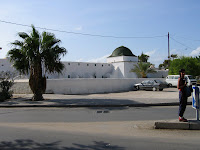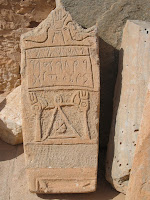Gettind down to writing based on notes taken during some of my trips is not easy, though some of the memories seem to be very vivid still.
The Djerba trip has not been chosen randomly, the fact that I have recently developed a skin rash which has not been identified yet made me think back to 2005 when under similar circumstances I headed to Djerba to see a dermatologist I felt could have the solution for the skin problem I had developed months earlier while travelling around the Nabeul area inTunisia.
I must confess that was not the prime reason for travelling there. It was the first trip Christian and I made together and it proved to be a very interesting one, despite the situation.
According to Greek Mithology Djerba was the home of seductive lotus eaters, having in Homer's Odyssey Ulisses almost lost his men when the beautiful maidens fed them with lotus flower. Legend or not I had to watch out ...
We rented bikes and "covered" the whole island in five days, having gone on an organised excursion for one full day and taken time to see the dermatologist in Midoun the first day.
Mosques were said to be numerous (and were) and their architecture greatly varied. The first one we saw was the Jemaâ Ettrouk (Mosque of the Turks) dating back to the 18th century with a minaret typical of the Otoman style.
Many others would follow, amongst which were the Mosque El May with its exquisite shape and the Lonely Mosque said to be more than 500 years old.
The co-existence of various ethnicities (in particular Berber, Arab and Black African) must have contributed towards such a variety but also various religious beliefs. The 1920 Synagogue of El-Ghriba bears witness of the rich Jewish heritage of the island, dating back 25 centuries, just after the destruction of the Temple of Solomon.
We didn't manage to visit it the first time as it was closed, but our curiosity made us come back two days later and it was worth it.
Worth noting was the Houmt Souk 19th century Catholic Church said to have been built for the Maltese, Italien and Greek fishermen who settled on the island.
The importance of religion within this fairly small island (514 km2) can also be accounted for in the number of Zaouïas, "Morabits" and other forms of religious beliefs.
An old Zaouïa dating back to the 18th century (Zaouïa de Sidi Zitouni) housed the Museum of Popular Arts and Traditions, which we visited. It provided us with a deeper insight into the complex and creative world of the traditional Arts which insist on surviving for the delight of people like me.

The 1432 castle and fort Borg El K'bir in the Houmt Souk with several artifacts on display inside the fort provided the setting for its historic "richness", as Houmt Souk developed on the site of an ancient Roman city, with many besides the Romans having lived there, including Numidians, Punics, Arabs, Spanish and Turks.
(to be continued)




























Djerba (em árabe: جربة) Diziam os antigos árabes que sonhar com um jasmim é uma professia de sucesso, apesar da sua fragilidade (uma leve brisa pode destruí-lo).
ReplyDeleteHomer tells how Ulysses, fleeing from the siren's haunting song, came across a beautiful island where delicate fruit grew: the home of the Lotus Eaters. All the sailors tasted the strange fruit – which some believe may have been dates – losing all memory of their homes and loved ones; only Ulysses himself abstained and so was able to save his crew and continue on his journey through the Mediterranean. Perhaps the people of Djerba are immune to effects of the fruit, as they tell this tale with pride, and bewitch the traveller with their warm and friendly welcome .
BELL GARCÍA